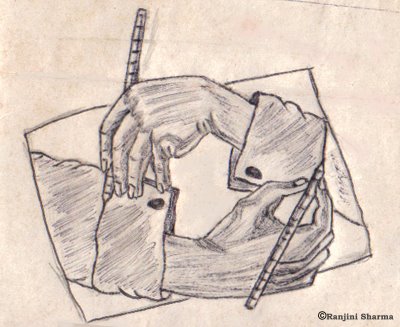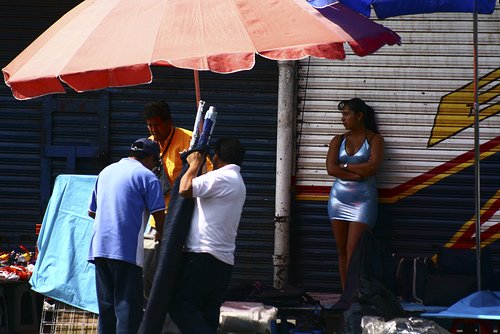In the popular imaginary a pimp is a mean man engaged in pushing a few prostitutes around and taking their money. Usually portrayed as black or foreign, he is made out to thrive on dressing up and showing off. Pimping is sometimes placed as part of gang business and competition, again with racist and xenophobic overtones. In these stereotypes street prostitution is usually assumed, though that is changing.
In anti-prostitution and anti-trafficking crusades and policy the word pimp is used to cover every case of a man benefiting from prostitution, whether by taking a percentage of sex workers’ earnings for work done (as a driver, or web-page tech, for example) or for living with sex workers, giving advice, providing back-up.
 Some want to distinguish clearly between those genuine helpers and the bad things ‘real pimps’ do, but I have learned over decades that trying to draw that line is a futile exercise. Sometimes sex workers love the men who push them around. Sometimes women pay men back in ways not visible to outsiders bent on seeing only one thing. Often the relationship is temporarily convenient and may be fluid, drifting back and forth between desired and consensual and not.
Some want to distinguish clearly between those genuine helpers and the bad things ‘real pimps’ do, but I have learned over decades that trying to draw that line is a futile exercise. Sometimes sex workers love the men who push them around. Sometimes women pay men back in ways not visible to outsiders bent on seeing only one thing. Often the relationship is temporarily convenient and may be fluid, drifting back and forth between desired and consensual and not.
Rarely do we get a sense of pimping as a job in an organisation, the sort of ‘organised crime’ that anti-trafficking police forces and the UN go on about. As with so many aspects of the sex industry most people know absolutely nothing about how it can work. When I suggested a field called the Cultural Study of Commercial Sex I said policy (prostitution law, sex-venue licensing, red-light districting, employment rules) would benefit from knowing more instead of staying on the ignorant outskirts. Moralising is very often a form of ignorance. This applies to the world of mediators, facilitators, agents, smugglers, madams and pimps.
The narrator of Jo Nesbø’s Blood on Snow is explaining how he came to be a fixer (hit-man) for a villain. There were various jobs available, and he tried several: driving get-away cars, robbery, drugs-dealing and pimping. In the following story he was on a low rung in the pimping business where Hoffmann is the top boss and Pine his second man. The place is Oslo.
Prostitution. I don’t have a problem with women earning money whatever way they like, and the idea that a bloke – me, for instance – should get a third of the money for sorting things out so the women can concentrate on the actual work. A good pimp is worth every krone they pay him, I’ve always thought that. The problem is that I fall in love so quickly, and then I stop seeing it in terms of business. And I can’t handle shaking, hitting or threatening the women, whether or not I’m in love with them. Something to do with my mother, maybe, what do I know? That’s probably why I can’t stand seeing other people beating up women either. Something just snaps. Take Maria, for instance. Deaf and dumb, with a limp. I don’t know what those two things have got to do with each other – nothing probably – but it’s a bit like once you get started getting bad cards, they just keep coming. Which is probably why Maria ended up with an idiot junkie boyfriend as well. He had a fancy French name, Myriel, but owed Hoffman thirteen thousand for drugs. The first time I saw her was when Pine, Hoffmann’s head pimp, pointed out a girl in a home-made coat and with her hair up in a bun, looking like she’d just left church. She was sitting on the steps in front of Ridderhallen, crying, and Pine told me she was going to have to pay back her boyfriend’s drug debt in kind. I thought it best to give her a gentle start, just hand-jobs. But she jumped out of the first car she got into after barely ten seconds. She stood there in floods of tears while Pine yelled at her. Maybe he thought she’d hear him if he shouted loud enough. Maybe that was what did it. The yelling. And my mum. Either way, something snapped, and even if I could see what Pine was trying to get into her head I ended up decking him, my own boss. Then I took Maria to a flat I knew was empty, then went to tell Hoffmann that I was no use as a pimp either. Blood on Snow, pp 6-7, Jo Nesbø
In my own The Three-Headed Dog, a strongman working for an organisation is looking for a new job. Sarac’s career has included soldiering as a very young man and a range of jobs lumped together as Security, in different parts of Europe and in the Caribbean. He is told his next job will be in West Africa, but he doesn’t want to go, feels comfortable on the Costa del Sol and is now looking for a way to stay. He is approached by a man with a job offer.
‘You have to specialise according to what work the people travelling are going to do. You have to use contacts specific to the sector. For instance, it might sound strange, but I have no good contacts in construction on the coast, or in property development. Those are competitive areas it would be stupid to try to get into. But I do know someone with long experience in the flats. Apartments where women work. You understand. And that’s just here. In the region we can call home I have a few powerful names. The operation would be high-quality, and there are different directions to take. A wide range of businesses, no need to deal with the low end.’ He paused. Sarac betrayed no reaction. Tarts, he thought. Bloody pimp-ing. The very last thing he was looking for. The Three-Headed Dog, Laura Agustín
If you’re interested in fiction’s genre labels: Nesbø’s book is placed as Nordic Noir; the Dog as Mediterranean Noir. Noir is about moral ambiguity, as when a pimp can’t stand abusing women so becomes a hard-boiled killer instead. Sarac is looking for something else to do, and has to get there using strong arms. What else does he have, after all? When police and moral entrepreneurs rant about putting criminal men in prison I often think: What jobs do they imagine to be available for men and boys cut out of the mainstream, with no access to anything but the lowest-class, worst-paid work, no expectation of social mobility or respect? Perhaps those thinking about ‘root-causes’ of prostitution and trafficking might consider that, rather than figuring them all as evildoers to be imprisoned for long terms, in prisons that only teach them better techniques for crime.
-Laura Agustín, the Naked Anthropologist



Pingback: Interview: Laura Agustín | The Honest Courtesan
Pingback: Bildebenen der „Prostitution“ – Und wie sie uns unweigerlich ein Werturteil abringen – Moral Iconographies